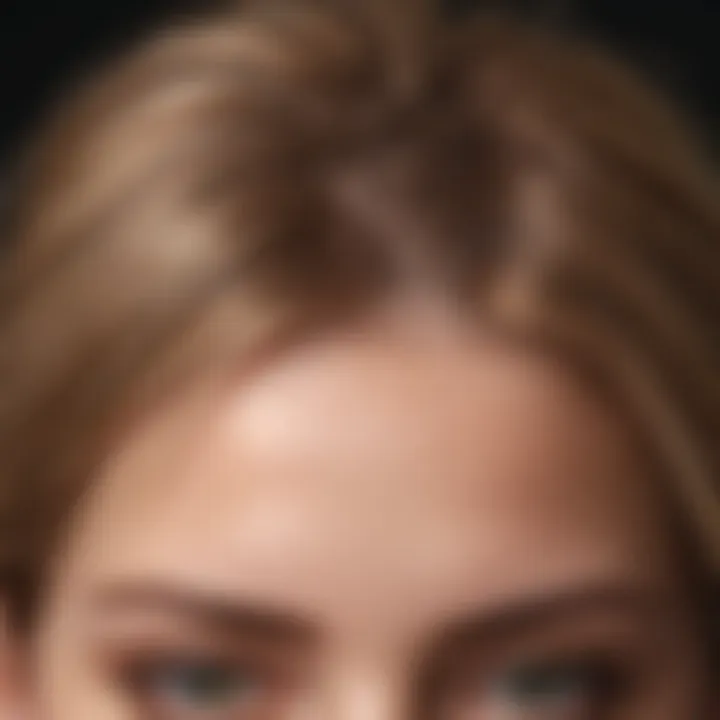Is Shampooing Necessary? Examining Hair Care Routines


Intro
In the world of hair care, the question of whether shampooing is truly necessary stirs quite the debate. There are those who swear by their daily wash, while others argue that hair can thrive without it. As we navigate this topic, we will explore the benefits of shampooing, identify the drawbacks, and examine various hair types and conditions that influence individual needs.
Shampoo has long been a staple in hair care routines, but trends and beauty philosophies are shifting. The understanding of hair and scalp health has evolved significantly, prompting many to reevaluate their approaches to cleanliness and care. This investigation goes beyond mere opinions; it seeks to uncover the science behind how we clean our hair in relation to modern practices.
Readers may find themselves asking: Is their shampooing ritual leading to healthier hair, or is it causing more harm than good?
We'll delve into alternatives to traditional shampoo, examine products that can help maintain scalp health, and consider lifestyle choices that impact overall hair wellness. By the end of our exploration, individuals looking to optimize their hair care routine will have a clearer perspective on what actually benefits their unique hair type.
Understanding Shampooing
In examining the intricacies of hair care, the topic of shampooing emerges as pivotal, serving both a functional and cultural role. Shampooing does not merely cleanse the hair; it also nourishes the scalp and shapes personal hygiene practices across generations. As our understanding of hair care has evolved, so too has the perception of what shampooing entails — from ritualistic practices steeped in tradition to a modernized approach tailored to individual needs. Understanding shampooing involves recognizing its various dimensions, including its definition, historical roots, purpose, and its position in current beauty trends.
Definition and Purpose
At its core, shampooing is the washing of hair with a product designed to remove dirt, excess oil, and product buildup. The primary purpose is to promote a clean scalp and healthy hair. Over the years, the ingredients in shampoos have diversified — from traditional surfactants that provide lather to contemporary formulations boasting natural oils and botanicals aimed at enhancing hydration.
The key benefit of shampooing lies in its ability to maintain balance. A clean scalp promotes hair growth and mitigates issues such as dandruff, while removing pollutants that can weigh down hair. Additionally, specific shampoos cater to distinct hair types, addressing unique needs based on texture, porosity, and previous chemical treatments. The conversation around shampooing is not only about cleaning but also about how one can tailor their routine to meet personal hair goals, whether that be enhanced shine, reduced frizz, or improved moisture retention.
Historical Context
Historically, the concept of cleansing hair has roots that stretch back thousands of years. Ancient civilizations employed a variety of methods using natural substances. For instance, Egyptians used oils and perfumes, while in China, herbal concoctions were common to promote good hair health. In many cultures, how one cared for their hair reflected social status and personal identity.
As the mid-20th century approached, commercial shampoos began to trickle into homes, leading to a widespread ritual of regular hair washing. Brands like Head & Shoulders and Pantene changed the landscape of hair care; they introduced the idea of specialized care, pushing shampooing into a daily necessity rather than an occasional practice. Today, shampooing remains highly normalized in society, yet the methods and practices continue to evolve in response to scientific findings and changing beauty standards.
Ultimately, the importance of understanding shampooing goes beyond simply knowing the procedure. It encompasses the awareness of its roots, the context of its use, and how our contemporary beliefs about hair care are continually shaped by both science and culture.
The Science Behind Hair and Scalp
Understanding the science of hair and scalp is essential for anyone who is serious about hair care. Hair isn’t just strands that hang from our heads; it's a sophisticated structure that needs proper care to keep it healthy and vibrant. Our scalp too plays a pivotal role in the health of hair. When it comes to caring for our locks, we ought to think about the underlying biology before making decisions about shampooing, styling, or even treatments.
Composition of Hair
Hair is predominantly made of a protein called keratin, which forms the structure of each strand. This robust building block is what keeps our hair from being damaged too easily, giving it strength and resilience.
Keratin's Role
Keratin plays a crucial part in maintaining hair strength. It acts as a protective shield, preventing breakage and allowing hair to retain its natural shape. Its presence is often synonymous with healthy hair; the more intact the keratin, the less likely the hair is to frizz or break under pressure. When people talk about smoothing treatments, they often refer to keratin treatments, which are popular among those seeking sleek, manageable hair.
However, it's vital to note that while keratin can aid in recovery from damage, overloading the hair with keratin-based products can lead to stiffness or an unnatural feel—definitely not ideal.
The Impact of Natural Oils
Natural oils, intrinsic to our hair and scalp, serve a host of purposes. They lock in moisture and provide nourishment to the hair while also acting as a natural barrier against environmental pollutants. Each person’s scalp produces sebum, which helps in giving hair a sheen and making it manageable. This is vital for maintaining overall hair health.
Yet, there’s a catch. Excessive oil can make hair appear greasy and unkempt, leading some to rely on shampoo to strip away this natural oil. It becomes a tricky balance—too much oil can be a hassle, but too little can lead to dryness and brittleness.
Scalp Health
A healthy scalp is the foundation of healthy hair. If the scalp is suffering from conditions like dryness, inflammation, or excessive oiliness, one's hair can suffer too. Tackling scalp health remains critical for anyone interested in achieving luscious locks.
Sebum Production


Sebum is produced by sebaceous glands located on the scalp. This oily substance is fundamental as it keeps hair from drying out and prevents irritation. An adequate sebum level plays a significant role in preventing dandruff and flaking. However, it can become problematic. If the scalp produces too much sebum, it can lead to oily hair—which often results in people washing their hair more frequently in a bid to control greasiness. Knowing your sebum production level can help you tailor your hair care routine accordingly.
Common Scalp Conditions
Understanding common scalp conditions, like dandruff or psoriasis, provides insight into how scalp inconsistency can impact hair growth and health. Dry patches on the scalp can lead to itching and flaking, which can be quite bothersome. By recognizing when to seek treatment or when to adjust your hair care routine, you can better manage these conditions. Regularly checking in on your scalp health along with a balanced approach to cleansing can ensure both scalp and hair are in optimal condition.
"A healthy scalp is essential for healthy hair."
Taking time to understand the science behind our hair and scalp offers invaluable lessons for anyone invested in their hair care regimen. Individual needs may vary, but with the right knowledge, we can all make informed choices about how best to care for our crowning glory.
Benefits of Shampooing
Understanding the benefits of shampooing is foundational in evaluating its role in hair care routines. While many people continue to use shampoo as a primary method for cleansing the scalp and hair, the importance of this practice extends beyond aesthetics. The act of shampooing contributes significantly to overall hair health, offering a range of advantages that resonate particularly well with women of various ages seeking to achieve and maintain beautiful hair.
Effective Cleansing
At its core, shampooing serves the crucial function of cleansing. Our hair and scalp accumulate oil, dirt, and environmental pollutants that can hinder hair's natural shine and luster. Clean hair not only looks better but also feels more manageable. Using a quality shampoo effectively strips away impurities, making way for healthier, shinier strands. This is especially important for those with oily scalps, as an adequate cleaning ritual decreases the chances of greasiness and buildup.
"A well-chosen shampoo can be your hair's best friend—making it glow free of impurities."
Shampoos are specifically formulated with ingredients designed to emulsify dirt and oil, allowing for easy rinsing. Ingredients such as surfactants are powerful agents that get deep into the hair shaft, ensuring grime is lifted away. For example, ammonium lauryl sulfate is an effective surfactant found in many shampoos, known for its superior cleansing ability. It’s vital to choose one that complements your hair type to achieve the best outcomes.
Product Residue Removal
An often-overlooked aspect of shampooing is its ability to remove product residue. Many hair care products like gels, mousses, or heat protectants can leave behind a sticky film that weighs hair down and makes it harder to style. Frequent layering of these products can lead to a buildup that may not wash out with just water. This is where shampoo shines; it can break down and wash away residues, preventing hair from feeling lifeless and dull.
Moreover, clarifying shampoos are specifically designed for this purpose and are worthwhile for anyone who frequently uses styling products. They can be particularly beneficial for those with thicker or curlier hair types, which may naturally attract more buildup. To maintain healthy hair, consider incorporating a clarifying wash into your routine every few weeks.
Enhancing Scalp Health
A healthy scalp is foundational to healthy hair growth, and shampooing plays a significant role in maintaining scalp health. The scalp, like the skin on your face, can be prone to conditions such as dandruff, itchiness, or even excessive oiliness. The right shampoo can target these issues effectively by creating an environment conducive to hair growth.
Shampoos containing ingredients like tea tree oil or salicylic acid can alleviate dandruff and reduce scalp inflammation, while those rich in natural oils can help maintain balance without stripping away essential moisture. Regular shampooing keeps the follicles clear of buildup, making it easier for new hair to sprout healthy and strong.
Drawbacks of Frequent Shampooing
Shampooing might seem like an essential part of daily hygiene for many, but it brings along a set of drawbacks that warrant consideration. Some people may find that lathering up day in and day out has unintended consequences for their hair and scalp health. Understanding these drawbacks can help individuals make informed decisions about their hair care routines, ensuring that their choices align with their personal hair needs.
Stripping Natural Oils
One of the major issues with frequent shampooing is the removal of natural oils. The scalp produces sebum, an oil that plays a vital role in protecting and moisturizing hair. Regularly washing your hair can strip these oils away, leaving the strands feeling dry and lifeless. This can lead to a cycle of overwashing: as the scalp becomes dryer, people often feel the need to shampoo more frequently to combat the perceived oiliness. Instead of purging excess grease, they may be exacerbating the problem.
Moreover, for those with curly or textured hair, the consequences can be even more pronounced. Curly hair tends to be drier because natural oils have a harder time traveling down the hair shaft. By shampooing too often, individuals with these hair types may find themselves grappling with frizz and breakage instead of the well-defined curls they desire.
In essence, if a person keeps washing out the oil, it becomes harder for their hair to retain moisture and shine. As a result, others might perceive their hair as unhealthy or lacking in luster.
Hair Fragility
Frequent shampooing can also contribute to increased hair fragility. Every time someone washes their hair, it undergoes stress from the water and the shampoo's surfactants. These ingredients, while effective at removing dirt, can weaken hair strands over time. People may notice that their hair feels thinner, breaks more easily, or has split ends, resulting from this continuous stress.
Over time, hair that becomes weak and fragile can be difficult to manage. Poor hair health can interfere with the natural growth cycle, leading to thinning hair in some cases. It's crucial to remember that the hair isn't just a fiber; it deserves attention and care to maintain its strength and resilience.


Individuals might want to consider how they approach shampooing, perhaps limiting it to a couple of times a week while allowing their hair to adjust and rejuvenate.
The key takeaway? Moderation is vital.
In navigating the complexities of hair care, it becomes evident that too much shampoo can lead to significant issues, challenging the very purpose of cleanliness. Finding that middle ground between too much and too little cleansing can result in healthier, stronger hair.
Alternative Hair Care Approaches
As consumers become more aware of the chemicals in traditional hair care products, alternative hair care approaches have garnered significant attention. These methods provide a valuable insight into customizing hair care that better fits individual needs. Exploring techniques such as co-washing and dry shampoo reveals options that maintain hair cleanliness while minimizing potential damage. Each approach is unique, offering distinct benefits that cater to different hair types and lifestyles. Understanding these alternatives can enhance overall hair health, making it easier to select the most appropriate method for one’s personal regimen.
Co-Washing
Definition and Benefits
Co-washing, short for conditioning washing, involves using a conditioner instead of shampoo to cleanse the hair. This technique has gained traction especially among individuals with textured hair, as traditional shampoos can often strip essential oils. One key characteristic of co-washing is its ability to retain moisture, making hair feel softer and more manageable. Many who adopt co-washing report that their hair appears shinier and has better curl definition. Additionally, co-washing is generally gentler, avoiding the harsh cleansing agents found in most shampoos, often leading to less breakage and damage overall. However, individuals must be mindful of selecting the right conditions that don’t contain silicones, as these products can build up over time and counteract the benefits of co-washing.
Best Practices
To make the most of co-washing, there are a few best practices to keep in mind. First, choosing the right conditioner is critical. It’s wise to opt for a product that is sulfate-free and specifically formulated for co-washing. Those practicing this must also be diligent in how they apply the conditioner - ensuring even distribution from the scalp to the ends can enhance its efficacy. Invigorating the scalp while applying the product can promote blood circulation and prevent buildup, creating a healthier environment. As opposed to using shampoo, co-washing could also suit those who exercise frequently, as it allows for regular cleansing without the drying effects of shampoo. Yet, it’s best to incorporate an occasional traditional wash to remove buildup, balancing between methods for optimal benefits.
Dry Shampoo
Usage Tips
Dry shampoo has become a lifesaver for many in today’s fast-paced world. This innovative approach essentially absorbs oil and refreshes hair without the need for water. Key to its charm is convenience, especially for individuals with busy lifestyles. To effectively use dry shampoo, one should apply it mainly on the roots and allow it some time to absorb oil before styling or brushing it in. Many recommend using dry shampoo not just as a last-minute fix but as a complement to the regular hair care routine - perhaps after a workout or on days where a full wash seems impractical. This versatility makes it an attractive addition to many users’ arsenal, particularly for those on the move.
Limitations
While dry shampoo offers remarkable ease, it does come with its drawbacks. One primary limitation is that it doesn’t replace the need for traditional washing. This product can lead to buildup on the scalp and hair over time, which might trigger irritation or dandruff for some. Additionally, relying too heavily on dry shampoo can mask underlying issues that may require deeper cleansing. It's worth noting that dry shampoos vary significantly in formulation, with some containing alcohol or fragrances, which can be problematic for sensitive scalps. Being aware of these limitations enables users to incorporate dry shampoo wisely, using it strategically rather than as a complete substitute for shampooing.
Keeping a careful eye on how often you use dry shampoo can help maintain your hair's health and cleanliness.
Shampooing Based on Hair Types
When it comes to hair care, one size does not fit all. The approach to shampooing should cater to the unique qualities and needs of each hair type. Understanding the specific elements, benefits, and considerations related to shampooing based on hair types can lead to healthier strands and a more enjoyable grooming experience. This section delves into the distinct needs of straight, curly, and colored or chemically treated hair, offering tailored advice for each.
Straight Hair
Straight hair tends to be more resilient than other types, but it also has its share of challenges. This hair type often produces an abundance of natural oils, which can make it appear greasy if not cared for properly. Therefore, selecting the right shampoo is crucial. Clarifying shampoos, used every couple of weeks, can help eliminate build-up without stripping hair of its moisture too much. Cleansing shampoos that incorporate gentle surfactants are ideal for regular use, allowing the hair's natural shine without overwhelming it.
For straight-haired individuals, here are some tips:
- Use a lightweight conditioner to avoid weighing the hair down.
- Avoid frequent washes; 2-3 times a week is typically adequate.
- Prioritize pH balance in your shampoo to maintain scalp health.
In summary, the goal is to retain moisture while managing oil production. Therefore, understanding your scalp's needs allows for cleaner, shinier, and healthier straight hair.
Curly Hair
Curly hair presents a delightful yet delicate challenge. With its tendency to be drier and more prone to frizz, curly hair necessitates a different approach to shampooing. Using sulfate-free shampoos is a smart move as it helps retain the natural moisture balance of curls. Co-washing, or washing with conditioner alone, can be particularly beneficial for curly hair types, as it cleanses without over-drying.
Points to keep in mind:


- Moisturizing shampoos are essential. Look for those enriched with natural oils like argan or jojoba.
- Be liberal with the conditioner, ensuring all curls are well-hydrated.
- Try to wash only once a week or every ten days to preserve your hair's natural oils and moisture.
Curly-haired women can achieve definition and shine by tailoring their cleansing routine while keeping in mind the unique structure of their hair.
Colored and Chemically Treated Hair
The vibrant hues and styles admired by many often come with unintended consequences. Colored and chemically treated hair can be particularly vulnerable to damage. This hair type demands gentle care to preserve vibrancy and strength, making the choice of shampoo vital. Color-safe shampoos that are sulfate-free will help maintain the integrity of the color while cleansing effectively.
Additionally, some considerations are:
- Use shampoos designed for color-treated hair, as they often contain ingredients protecting against color fade.
- Limit washing frequency — once or twice a week can help keep the hue fresh longer.
- Deep conditioning treatments can be world-saving, and integrating them into your routine can combat dryness or brittleness often associated with chemical treatments.
Cultural Perspectives on Shampooing
Understanding shampooing within the lens of culture opens up a dialogue about how personal care rituals are shaped by varying beliefs, customs, and practices across the globe. Cultural perspectives on shampooing not only highlight the rich tapestry of hair care routines but also underscore significant influences such as environmental conditions, local resources, and societal norms. In this regard, it becomes essential to explore both global practices and the prevailing beauty standards that guide how people perceive and maintain their hair.
Global Practices
Traditional Methods
Traditional methods of hair cleansing often stem from generations of accumulated wisdom. Across many cultures, people have resorted to natural ingredients before the advent of commercial shampoos. For instance, in parts of India, a mixture of reetha (soap nuts) and shikakai is commonly used. These natural cleansers are lauded for being gentle yet effective, offering a way to keep hair clean without stripping away essential oils. Their key characteristic lies in their plant-based origins, making them not only eco-friendly but also a popular choice among those conscious of chemical ingredients.
The unique feature of traditional methods is their holistic approach to hair care; they often include additional benefits such as conditioning or even promoting hair growth. However, these methods may not cater to all hair types or lifestyle needs, potentially leading to a lack of convenience compared to modern products.
Modern Trends
Modern trends in hair care have increasingly shifted towards convenience and effectiveness, driven by technological advancements in product formulation. Many individuals now rely on commercially produced shampoos that cater to specific hair types and needs. These products often promise quicker results and are designed to fit seamlessly into busy lifestyles. One notable characteristic is the wide array of options available, from clarifying shampoos to those formulated for color-treated hair.
While the unique feature of modern trends is their targeted approach, focusing on specific hair concerns, these options can sometimes come with a trade-off. The presence of synthetic ingredients may lead to concerns about potential long-term effects on hair health and the environment, raising questions about sustainability in the hair care industry.
Influence of Beauty Standards
Beauty standards profoundly impact how societies view hair and, consequently, the necessity of shampooing. In many cultures, healthy, shiny hair is not just seen as a sign of beauty but also as a social asset that reflects personal care. The pressure to conform to these ideals often dictates the frequency and method of shampooing. For example, in societies where straight, smooth hair is favored, individuals might feel compelled to shampoo regularly to eliminate frizz or product buildup.
Conversely, the rise of movements promoting natural beauty has given birth to the acceptance of diverse hair textures and styles. This shift has encouraged many to reconsider their hair care routines, advocating for less frequent shampooing. In such contexts, it becomes evident that the relationship between shampooing and beauty standards is dynamic, evolving with societal values and personal preferences.
"Cultural beliefs about hair care are not just personal choices; they are deeply intertwined with identity, tradition, and self-expression."
Understanding the cultural perspectives on shampooing enriches our knowledge about hair care practices, offering insights into why certain methods resonate more with individuals from distinct backgrounds. Each cultural tradition not only serves practical functions—such as cleansing and conditioning—but also holds symbolic significance in reinforcing personal and collective identities.
Ending: To Shampoo or Not to Shampoo?
In taking a measured approach to hair care, discussing whether to shampoo or not is paramount. The conclusion draws together scattered threads of insights that emerged throughout this exploration of hair health. Understanding the intrinsic relationship between shampooing practices and hair type, scalp condition, and lifestyle choices lets each individual make an informed decision about their hair care routine.
One significant facet of shampooing lies in its ceremonious nature in many cultures. The act of cleansing the hair not only addresses hygiene but serves as a ritual. One must weigh the ceremonial aspect against the practical.
Key Takeaways
- Shampooing is not one-size-fits-all: Different hair types require varied approaches; a universal method is rarely the answer. It's essential to tailor the strategy to what works for individual strands.
- Observe and adapt to scalp health: Monitoring scalp conditions and how they respond to products can guide how often one should use shampoo. Overdoing it could lead to dryness, while not doing enough may cause an unhealthy buildup.
- Alternative methods hold water: Co-washing and utilizing dry shampoos can complement or substitute traditional shampoos effectively. These methods might be appealing especially to those with curly or coarse hair, requiring extra nourishment.
"It's not just about what you wash away; it's about what you retain—a balance of cleansing and nourishing is vital for truly holistic hair care."
Future of Hair Care
Looking ahead, the future of hair care hints at an even more personalized experience. Advances in technology, such as hair analysis using artificial intelligence, could soon tailor hair products specifically to an individual’s needs, thereby reducing excess trial and error. People are likely to prioritize natural ingredients and sustainable practices, shifting toward formulations that respect both hair and the environment.
Emerging trends also reflect a growing understanding of the complexities of hair. As discussions move away from strict routines towards intuitive care, we may find ourselves hanging on every strand's individual needs rather than adhering to rigid norms. The focus will shift from conventional methods to flexible approaches that approach hair care as dynamic.



